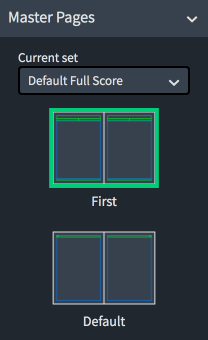Master pages
Master pages function like templates in Dorico Pro, allowing the same page formatting to be applied to multiple pages and in different layouts.
Page size and margins, page orientation, and staff size for all layouts are specified in .
All pages in your scores and parts inherit their layout formats from master pages. Whenever you create or change anything on master pages, this is automatically reflected on the pages that use these master pages. For example, if you insert a new frame on a master page, a corresponding frame appears on all the pages that use that master frame, so long as those pages do not have master page overrides.
In Dorico Pro, master pages consist of page pairs. Every page pair has a left and a right master page, so that if a page in your project falls on a left page, the formatting of the left page of the master page pair is used, and if a page falls on a right page, the formatting of the right page of the master page pair is used. In both the Master Pages section of the Pages panel and the master page editor, page pairs appear side-by-side.
Dorico Pro provides default master pages for first (First) and subsequent (Default) pages. This ensures that there is appropriate page formatting for first pages independently of subsequent pages, as the first page typically includes additional information, such as the title, composer, and copyright.
Master pages are contained in master page sets for full score and part layouts. Master page sets are automatically applied to every layout that you create.

You can customize the default master pages in the master page editor as required for the current project. You can also create new and custom master pages in each master page set.
Changing individual pages in layouts is considered a master page override in Dorico Pro, which is a type of page format change. This includes, for example, editing the title or running header on one page, rather than in the master page editor. Pages with master page overrides no longer get updated if you change the master page and are not automatically deleted, even if they are empty because the layout became shorter.